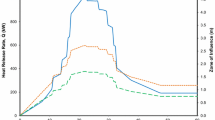Abstract
Probabilistic techniques offer rational methods of dealing with the randomness of fire risk and effectiveness of firesafety measures. In this paper the state of the art in these techniques is reviewed with examples illustrating the use of fire statistics in evaluating the parameters of these models. Methods discussed include exponential model of fire growth, probability distribution of damage, and stochastic model of fire spread. The estimates provided by these models can be used in conjunction with an engineering method for a probabilistic treatment of deterministic predictions.
Similar content being viewed by others
References
Watts, J.M.,Fire Safety Journal Vol. 11, 1986, pp.127–134.
Ramachandran, G.,Fire Safety Journal Vol. 2, 1979/80, pp.125–145.
Fire Statistics United Kingdom, Home Office, London, 1985.
Ramachandran, G., in Statistical Distributions in Scientific Work, Vol. 2, G.P. Patil et al. (eds), D. Reidel, Dordrecht, Holland, 1975.
Williamson, R.B.,Fire Safety Journal Vol. 3, 1981, pp. 243–259.
Ramachandran, G., “Stochastic Model of Fire Spread,” CIB Workshop on Mathematical Modelling of Fire Growth, Paris, 1981.
Fitzgerald, R.W.,Fire Safety Journal Vol. 9, 1985, pp.233–243.
Rutstein, R.,Fire Surveyor Vol. 8, No. 2, 1979, pp. 21–25.
Benktander, G.,ASTIN Bulletin Vol. 7, 1973, pp.119–136.
Apostolakis, G.,Nuclear Engineering and Design Vol. 71, 1982, pp. 375–381.
Butcher, G.,Fire Engineers Journal Vol. 47, No.144, 1987, pp.11–14.
Ramachandran, G., Information Paper IP27/80, 1980, Building Research Establishment, Fire Research Station, Borehamwood, Herts., U.K.
Thomas, P.H., Current paper No.32/74, 1974, Building Research Establishment, Fire Research Station, Borehamwood, Herts., U.K.
Labes, W.G.,Fire Technology Vol. 2, No. 4, 1966, pp. 287–297.
Heskestad, G., “Engineering Relations for Fire Plumes,” Society of Fire Protection Engineers, Technology Report 82-8, 1982.
Ramachandran, G.,Proceedings of the First International Symposium on Fire Safety Science Hemisphere Publishing Corporation, New York, 1986, pp.657–666.
Friedman, R.,Fire and Materials Vol. 2, No. 1, 1978, pp. 27–33.
Ramachandran, G., and Chandler, S.E.,Fire Surveyor Vol. 13, No. 2, 1984, pp. 8–14.
Shpilberg, D.C., Technical Report No. 22431, 1974, Factory Mutual Research Corporation, Norwood, Massachusetts, U.S.A.
Aitchison, J., and Brown, J.A.C.,The Log Normal Distribution, Monograph No.5, 1969, Department of Applied Economics, University of Cambridge.
Ramachandran, G.,Fire Safety Journal Vol. 5, 1982, pp. 59–76.
Rogers, F.E., Current Paper No. CP9/77, 1977, Building Research Establishment, Fire Research Station, Borehamwood, Herts., U.K.
Shpilberg, D.C., Paper for 12th ASTIN Colloquium, 1975, Report RC75-TP-36, Factory Mutual Research Corporation.
Theil, H.,Statistical Decomposition Analysis with Application in the Social and Administrative Sciences, North-Holland, Amsterdam 1972.
Ramachandran, G.,ASTIN Bulletin Vol. 8, 2, 1975, pp. 229–241.
Gretener, M., “Attempt to Calculate the Fire Risk of Industrial and Other Objects,” Third International Fire Protection Symposium, Eindhoven.
Nelson, H.E., and Shibe, A.J., “A System for Fire Safety Evaluation of Health Care Facilities,” Report NBS IR78-1555, Gaithersburg, Maryland, U.S.A.
Williamson, R.B.,Fire Safety Journal Vol. 3, 1981, pp. 243–259.
Kanury, A.M.,Fire Safety Journal Vol. 12, 1987, pp. 65–74.
Berlin, G.N.,Fire Technology, November 1980, pp. 287–302.
An Application of the Systems Approach to Estimating Levels of Fire Safety, NFPA Interim Technical Report, Nov. 1976, Dept. of Housing and Urban Development.
Ramachandran, G., in Fire Safety: Science and Engineering, ASTM STP882, T.Z. Harmathy, ed., Philadelphia, 1985, pp.122–144.
Aoki, Y., Research Paper No.80, 1978, Building Research Institute, Tokyo, Japan.
Williamson, R.B., inSixteenth Symposium (International) on Combustion The Combustion Institute, Pittsburgh, 1976, pp.1357–1371.
Ling, W.C.T., and Williamson, R.B., “The Modelling of Fire Spread Through Probabilistic Networks,” Contract No. W-7405-ENG-48, 1981, Nuclear Regulatory Commission, Lawrence Berkeley Laboratory.
Elms, D.G., and Buchanan, A.H., Research Report R-35, 1981, Building Research Association of New Zealand, Judgeford, New Zealand.
Beck, V.R.,Fire Safety Journal Vol. 12, 1987, pp. 121–138.
Fahy, R.F.,Fire Safety Journal Vol. 9, 1985, pp.189–203.
Author information
Authors and Affiliations
Rights and permissions
About this article
Cite this article
Ramachandran, G. Probabilistic approach to fire risk evaluation. Fire Technol 24, 204–226 (1988). https://doi.org/10.1007/BF01038178
Issue Date:
DOI: https://doi.org/10.1007/BF01038178



